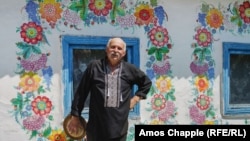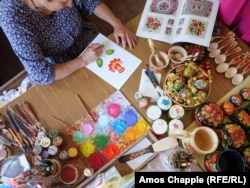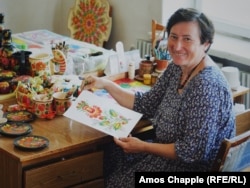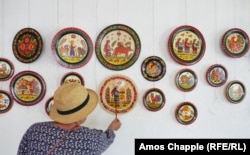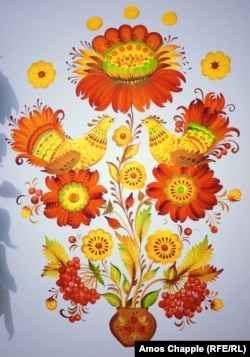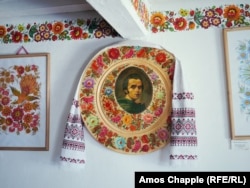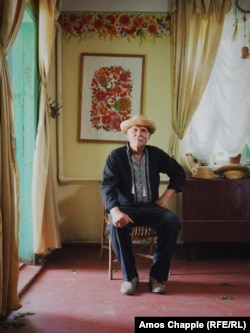Petrykivka painters are continuing their craft as missiles hammer eastern Ukraine and the town's historic art collection is transported to safety.
In the museum of Petrykivka in eastern Ukraine, one room stands empty.
Before Russia's February 24 invasion, the building held art treasures unique to the region, but now the museum’s curator says the paintings have been spirited away to a “secret” location for safekeeping.
Petrykivka is several hours’ drive from the frontline fighting in Ukraine, but on June 27, the same day RFE/RL visited the town, at least 20 people were killed when a 5.8-ton Russian missile obliterated a shopping center in Kremenchuk, less than 100 kilometers away. The next day, cruise missiles struck Dnipro, just 40 kilometers from Petrykivka.
Petrykivka painting is an ancient art form that once decorated the outside walls and interior stoves of Ukrainian village homes in the lush farming region around Dnipro. The candy-colored art was initially credited with warding off evil spirits and ensuring a fruitful, love-filled household.
In 2013, the art was inscribed on UNESCO's list of the world's Intangible Cultural Heritage.
The painting style dates back around 300 years, but early examples of the art have been lost to time due to the perishable materials used. Before paint and lacquer were introduced, the villagers of Petrykivka used natural dyes, including juices squeezed from sunflowers, beetroots, cherries, and grass. A glossy coating was made from boiled sugar.
Natalya Rybak is one of Petrykivka’s most well-known master painters and decorates items sold throughout Ukraine and abroad. Rybak says she "adores" her profession, adding, “If your work can bring joy to other people, then why not?”
Rybak says it is mostly women who paint in Petrykivka because “men have to do heavy physical work that stresses their bodies, whereas women can be neat and tidy with their brushstrokes.”
After the February 2022 invasion, the master artist says she stopped painting for three months due to anxiety but restarted recently.
“I found it calms me and helps me take my mind off the war,” she says.
According to Rybak, all professional painters in Petrykivka have their own paintbrushes made from cat fur, which is softer and more supple than other fibers and essential for authentic Petrykivka paintings. The cat needs to be of a "relaxed and happy" temperament, Rybak says, and is given a treat of sausage or lard after tufts of hair are snipped from the tip of its tail or from under its armpit.
Petrykivka paintings are distinctive for their fantastical birds and flowers, which are often exaggerated versions of reality. Many features of the paintings serve a symbolic role.
The hearth painting seen above in the Petrykivka Museum tells a story of love, family, and faith.
At the lowest level of the image, berries (each made with a single dab of a finger) represent deceased ancestors. Further up the artwork, two red flowers symbolize a husband and wife, while the hen-like birds represent love between the married couple. Above the birds, seeds in a sunflower-like plant represent children, then at the top of the image, three dots symbolize the Holy Trinity of God.
On the outskirts of Petrykivka, artist Mykola Deka runs a picturesque homestead that looks like a scene from the classic Soviet cartoon based on a Ukrainian folk tale Once Upon A Time There Lived A Dog.
The artist keeps the ancient Ukrainian tradition of painted houses alive by ringing the windows of his properties with flowers and berries in the Petrykivka style.
Deka, who has a guesthouse on his land, says that since war broke out international visits have stopped completely and only tourists from nearby Dnipro have booked into his property.
Deka says the arduous task of keeping the ornamental flowers and fruits fresh by repainting them each year is important "to keep our traditions alive."
Both Deka and Natalya Rybak say they intend to remain in their famous town, even as thousands of Ukrainians flee west.
When asked about the prospect of the Russian advance reaching Petrykivka, Rybak vowed to RFE/RL that she would stay in the town and continue with her art "no matter what."
